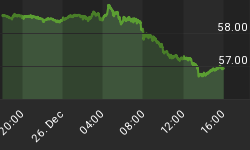Three days ago, Tuesday, we posted a Market Commentary with a chart of TEVA, an Israeli pharmaceutical company. It was around 1 a.m., several hours prior to the stock market open. This was the second paragraph:
For disclosure, we do not trade stocks, so this is just an exercise. Were a position to be taken, there is merit in a buy-stop order at 44.68, with a protective sell stop at 42.25.
...We post this now, in case 44.68 does trigger, so the recommendation would not appear to have been in hindsight.
More to come, soon.
This is the chart, as posted. The recommended buy stop was just above the box area, at the end of the chart. TEVA had two noted positives going for it: 1) A strong rally on very strong volume in mid-January. Here is a clear example of institutional buying in a stock. 2) TEVA was building another TR, [Trading Range], base, which if the breakout were to be to the upside, the base supported a move much higher, or at least somewhat higher.

An article was written, last November, Markets Talk Few Listen, in which we presented the very same concept as a valid approach for improving one's ability to make better trade selections. It explains why early January was the time and price to buy TEVA. The chart above shows a new trade that offers potential with a clearly defined risk.
It turns out TEVA was one of the largest stock holdings in a Soros Fund, at least as of last Quarter. That may or may not still hold true, which is immaterial because the noted spike in volume was the market's way of letting us know that institutions were buyers. It does not matter which institution[s]. When they buy, they buy for the longer term.
TEVA is measured against the pharmaceutical ETF, XPH, to determine its strength within that sector. TEVA was ready to have an upside breakout at the same time as the ETF.

TEVA is slightly under the similar chart structure of XPH. This would prompt a closer look at other pharmaceutical stocks that may be relatively stronger than TEVA, maybe even the ETF itself. It just happens that TEVA was the hand we were dealt, at the time, and mention is made to show how there is flexibility in how one wants to determine the quality of potential stock selections.
The increased volume, last bar on the chart, would raise some concern over the next day trade activity. The volume is similar to the January breakout volume, but the range of the bar is slightly smaller than the January range. Just something over which to be aware.
Because the Fed-driven stock market is at an advanced stage, one has to be quicker to respond to price activity, as opposed to say were this kind of breakout occurring during the early stages of a bull market, and one could exercise more patience.
Another way to be flexible is in the risk management of this trade. The stop can be raised up to the breakeven level, eliminating risk exposure entirely. On any further advance, profits can be taken on half the position to ensure a profitable trade. The point is, do not just buy and hold without taking an active role in managing each stock selection.

Here is an updated TEVA hourly chart. Price gapped higher on Tuesday morning, which would have triggered a 44.68 buy stop. The recommended buy could have been filled in the 45.40 area, with an initial stop-loss at 42.25, risking $3, initially.

















